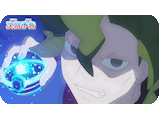
Movie and the Comic



Main
Old Updates Archive
Links
 |
Lists |
List of Pokemon
Pokemon World Atlas
List of Techniques
List
of Items
List of TV Episodes
 |
Guides |
Episode
Comparisons
Movies
& Specials Guide
CD Guide
DVD Guide
Voice
Actors Guide
Lyrics Archive
Manga
Guide
Video Games
 |
Miscellaneous |
Humor
Pokemon Bashing
Features
Rants
Dogasu's
Backpack
| Manga Guide | Mewtwo Strikes Back
| Story Synopsis | Differences
between the movie and
the comic |
About the
Author |
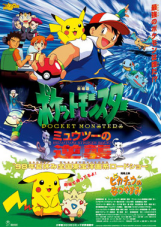 |
VS |
 |
The manga adaptation of Mewtwo
Strikes Back is only an adaptation in the loosest sense of the
word. While certain parts of it are similar the manga, for the
most
part, is doing its own thing. According to an interview with Ono
Toshihiro in Animerica magazine Volume 8 Issue 1, this wasn't entirely
his fault:
The "Birth of Mewtwo" radio drama wouldn't air until the beginning of June meaning that Mr. Ono would have had absolutely nothing to go off of when doing his version of the birth of Mewtwo.
| ANIMERICA:
You did a manga adaptation of Pokémon:
The First Movie. Were you working on this before the movie came
out? ONO: That movie came out in July of '98, and I received the scripts and continuity in April. I wrote the manga at the end of May. ANIMERICA: You said you did a manga adaptation of the Pokémon movie. Were you working on this before the movie came out? How does your manga version compare to the finished film? ONO: At first I was told to draw Mewtwo’s birth, which wasn’t included in the movie, so I made a manga out of the first half of the movie, centering on the meeting of Mewtwo and the professor (until the part where Ash heads to Mewtwo’s island). But after that the anime staff wrote an original “Birth of Mewtwo” episode that was produced, so there’s not much connection between the manga and the movie. |
The "Birth of Mewtwo" radio drama wouldn't air until the beginning of June meaning that Mr. Ono would have had absolutely nothing to go off of when doing his version of the birth of Mewtwo.
| Mew's
Ai-lash |
Fuji-Hakase's family does not
exist in the manga adaptation. No mention is ever made of a wife
or daughter, meaning that his reason for seeking out Mew in the
first place is completely different.

In the radio drama / movie the reason Fuji-Hakase is driven to clone Mew is because it supposedly holds the secrets to life itself. If he can figure those out, Fuji-Hakase believes, he'll be able to find a way to bring his dead little girl back to life. It's a tragic story made even more so by the fact that Fuji-Hakase never really achieves his goal before being killed by Mewtwo.
In the manga, however, Fuji-Hakase is motivated by revenge. He was driven out of some institute because of his "Pokemon Gene Reconstruction Plan" and wants to clone Mew in order to prove his ex-colleagues wrong. When he receives the orders from Sakaki to go one step further and actually create a pokemon better than Mew then how could he refuse?

Fuji-Hakase is also never identified by name in the manga, though to be fair he's never identified by name in the movie either.

In the radio drama / movie the reason Fuji-Hakase is driven to clone Mew is because it supposedly holds the secrets to life itself. If he can figure those out, Fuji-Hakase believes, he'll be able to find a way to bring his dead little girl back to life. It's a tragic story made even more so by the fact that Fuji-Hakase never really achieves his goal before being killed by Mewtwo.
In the manga, however, Fuji-Hakase is motivated by revenge. He was driven out of some institute because of his "Pokemon Gene Reconstruction Plan" and wants to clone Mew in order to prove his ex-colleagues wrong. When he receives the orders from Sakaki to go one step further and actually create a pokemon better than Mew then how could he refuse?

Fuji-Hakase is also never identified by name in the manga, though to be fair he's never identified by name in the movie either.
| Fuji-Hakase
and Mew |
Nobody on the South American research team
actually meets Mew in the movie but Fuji-Hakase becomes
friends with the mythical pokemon in the manga adaptation.

The two become so close that Mew even allows Fuji-Hakase to pluck out one of its eyelashes. In the movie and the radio drama the Rocket-Dan's researchers just kind of find it somewhere.
The two are inseparable until the day Sakaki orders Fuji-Hakase to create Mewtwo. The professor gets so wrapped up in his work - motivated, as mentioned earlier, by his desire for revenge - that he completely neglects the mythical pokemon. Mew leaves him but by the time Fuji-Hakase notices he's already gone mad.

The professor would snap back to his senses shortly before his death, however.
We all know how Fuji-Hakase dies in the movie: Mewtwo is born, gets pissed off at its creators for bringing it into the world in the first place, and decides to destroy the place.

In the manga, however, Mewtwo destroys the lab because Fuji-Hakase asks him to. Sakaki, happy with the way Mewtwo was going, decided that he wanted to put the pokemon into mass production to create an army of Mewtwo. The idea was to strip Mewtwo of all emotion and empathy and to create a mindless weapon capable of unspeakable acts of destruction.
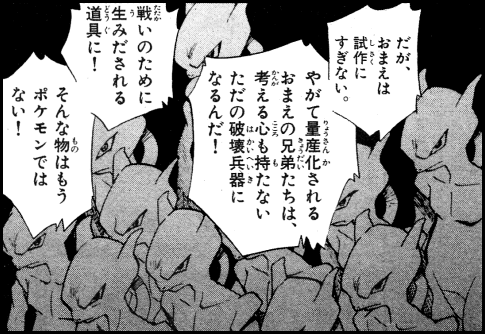
Fuji-Hakase didn't want to see this become a reality so he begs Mewtwo to destroy the lab and everyone in it.

Mewtwo protests at first because Fuji-Hakase is its parent but it eventually decides to follow its creator's orders anyway.
Mewtwo Strikes Back was a trendsetter in a lot of ways and one of the things it introduced to the Pocket Monsters movie was the idea of a legendary pokemon using telepathy to communicate with humans.
In the manga adaptation, however, Mewtwo actually talks. As in, it opens its mouth and talks just like the Rocket-Dan's Nyasu does. Take a look:
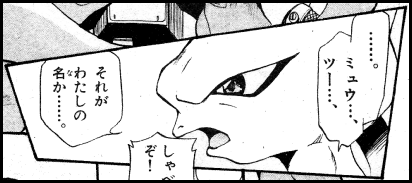
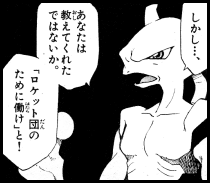
Freaky, huh?

The two become so close that Mew even allows Fuji-Hakase to pluck out one of its eyelashes. In the movie and the radio drama the Rocket-Dan's researchers just kind of find it somewhere.
The two are inseparable until the day Sakaki orders Fuji-Hakase to create Mewtwo. The professor gets so wrapped up in his work - motivated, as mentioned earlier, by his desire for revenge - that he completely neglects the mythical pokemon. Mew leaves him but by the time Fuji-Hakase notices he's already gone mad.

The professor would snap back to his senses shortly before his death, however.
| Fuji-Hakase's
Death |
We all know how Fuji-Hakase dies in the movie: Mewtwo is born, gets pissed off at its creators for bringing it into the world in the first place, and decides to destroy the place.

In the manga, however, Mewtwo destroys the lab because Fuji-Hakase asks him to. Sakaki, happy with the way Mewtwo was going, decided that he wanted to put the pokemon into mass production to create an army of Mewtwo. The idea was to strip Mewtwo of all emotion and empathy and to create a mindless weapon capable of unspeakable acts of destruction.

Fuji-Hakase didn't want to see this become a reality so he begs Mewtwo to destroy the lab and everyone in it.

Mewtwo protests at first because Fuji-Hakase is its parent but it eventually decides to follow its creator's orders anyway.
| Mewtwo
Talks Back |
Mewtwo Strikes Back was a trendsetter in a lot of ways and one of the things it introduced to the Pocket Monsters movie was the idea of a legendary pokemon using telepathy to communicate with humans.
In the manga adaptation, however, Mewtwo actually talks. As in, it opens its mouth and talks just like the Rocket-Dan's Nyasu does. Take a look:


Freaky, huh?
| Raymond
Johnson |
One of the things the Pocket Monsters movies have been
doing since the very beginning is get special guest stars to come in
and voice certain characters. In this movie we have Ichimura
Masachika as Mewtwo, Kobayashi Sachiko as Voyager, Satou Aiko as Sweet
/ narrator of the Pikachu short, and Raymond Johnson as the Pirate-like
trainer.
Raymond Johnson was one of the hosts of the kids' morning show Oha Suta from 1997 until 2001 along with Yamadera Kou'ichi. Here's an interview with the American-born entertainer from around 1999-ish that tells you a little bit more about him.

This is what his character looks like in the manga adaptation vs. the animated movie:
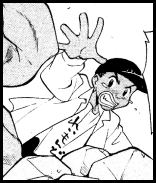
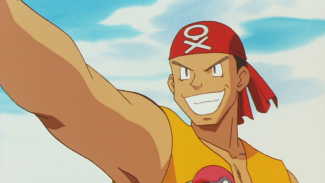
Quite a huge difference, huh? The manga adaptation has the Trainer who fights against Satoshi actually resemble his voice actor - dark skin, signature baseball cap, a T-shirt that says れいもんど ("Raymond") down the front - while the character in the movie looks nothing like him.
I don't know about you but I like this version a lot better.
Raymond Johnson was one of the hosts of the kids' morning show Oha Suta from 1997 until 2001 along with Yamadera Kou'ichi. Here's an interview with the American-born entertainer from around 1999-ish that tells you a little bit more about him.

This is what his character looks like in the manga adaptation vs. the animated movie:


Quite a huge difference, huh? The manga adaptation has the Trainer who fights against Satoshi actually resemble his voice actor - dark skin, signature baseball cap, a T-shirt that says れいもんど ("Raymond") down the front - while the character in the movie looks nothing like him.
| Invitation
to New Island |
Mewtwo invites Satoshi and his friends to
New Island by sending a Kairyuu to wherever Satoshi is and having it
deliver a postcard (it was Japan in the 90s, what do you
expect?).

In the manga, however, Mewtwo actually crashes the Pokemon League.
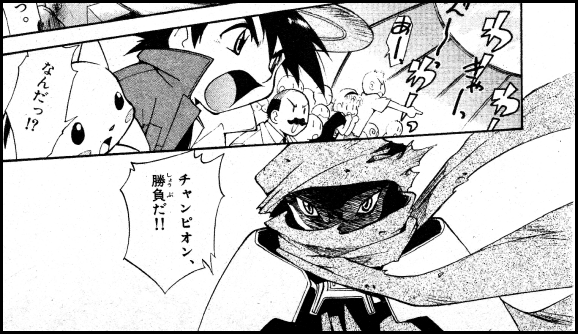
To be fair, it's not the Pokemon League but rather the "Pokemon League CoroCoro Cup," a special tournament whose name is taken from the magazine this manga appears in. Once the final battle of the league is over Mewtwo comes in, dressed in a cloak, and immediately challenges the newly crowned Champion to a battle. The Champion does not fare well.
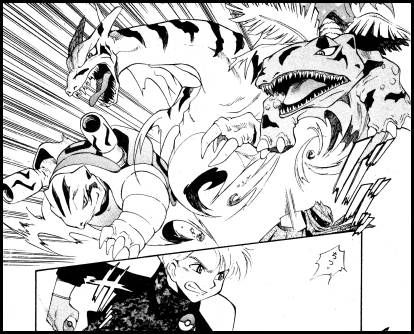
After the battle, Mewtwo is disappointed that this was the best the so-called "Champion" could do and issues a challenge to everyone in the stadium: come to New Island in one week if you want to battle me, the strongest Pokemon Master.
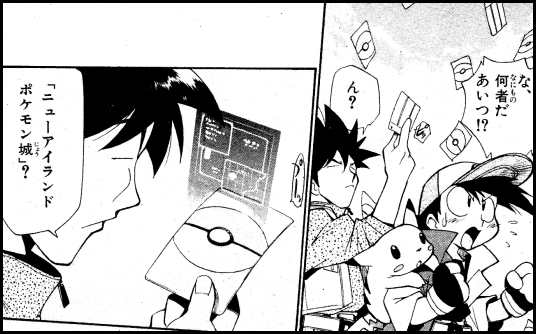

In the manga, however, Mewtwo actually crashes the Pokemon League.

To be fair, it's not the Pokemon League but rather the "Pokemon League CoroCoro Cup," a special tournament whose name is taken from the magazine this manga appears in. Once the final battle of the league is over Mewtwo comes in, dressed in a cloak, and immediately challenges the newly crowned Champion to a battle. The Champion does not fare well.

After the battle, Mewtwo is disappointed that this was the best the so-called "Champion" could do and issues a challenge to everyone in the stadium: come to New Island in one week if you want to battle me, the strongest Pokemon Master.

I don't know about you but I like this version a lot better.
| The
Rocket Trio |
The
final difference I'm going to talk about has to do with the Rocket
trio's involvement in the story.
In the movie, the Rocket trio first get involved when they intercept the messenger Kairyuu on its way back to Mewtwo's castle. They see the postcard fall out of the pokemon's bag and decide to follow our heroes to see what this whole "strongest Pokemon Master" thing is about.
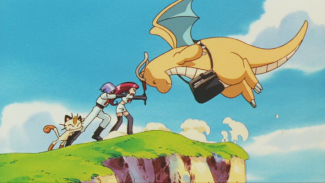
In the manga, however, the Rocket trio are first seen outside Mewtwo's castle and are about to infiltrate it on their Boss' orders. Though it's never explicitly stated, it's obvious that we're meant to assume that they were ordered to break into the castle to retrieve the Rocket-Dan's secrets that it must contain.
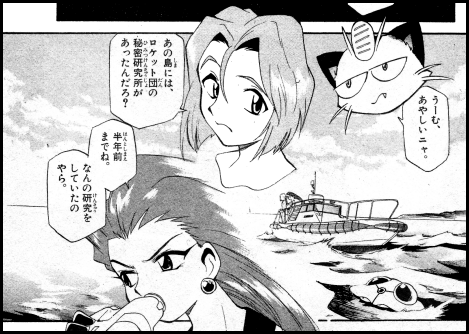
They don't actually break in that day, however, and instead show up at that port a week later with everybody else. We never really find out why.

The manga adaptation ends right when Satoshi and his friends arrive at New Island so unfortunately we don't know what other alterations Mr. Ono had up his sleeve for the rest of the movie.
In the movie, the Rocket trio first get involved when they intercept the messenger Kairyuu on its way back to Mewtwo's castle. They see the postcard fall out of the pokemon's bag and decide to follow our heroes to see what this whole "strongest Pokemon Master" thing is about.

In the manga, however, the Rocket trio are first seen outside Mewtwo's castle and are about to infiltrate it on their Boss' orders. Though it's never explicitly stated, it's obvious that we're meant to assume that they were ordered to break into the castle to retrieve the Rocket-Dan's secrets that it must contain.

They don't actually break in that day, however, and instead show up at that port a week later with everybody else. We never really find out why.

The manga adaptation ends right when Satoshi and his friends arrive at New Island so unfortunately we don't know what other alterations Mr. Ono had up his sleeve for the rest of the movie.
Found an error? Spot an omission? Please help me keep this page current and error-free by e-mailing me with a description of the error or omission.

